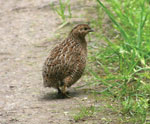Volume 26, Number 7—July 2020
Etymologia
Etymologia: Rhabdomyolysis
On This Page
Figures
Downloads
Article Metrics
From the Greek rhabdos (“rod”) + mus (“muscle”) + lusis (“loosening”), rhabdomyolysis refers to the rapid breakdown of skeletal (striated) muscle, releasing myoglobin into the blood, which can lead to kidney failure. In the Book of Numbers in the Bible, the Israelites grew tired of eating manna. They demanded that God send them meat. God, angry at their insolence, sent them quail but then strikes those who ate the meat with a plague (Numbers 11:31–35). This may have been an early account of rhabdomyolysis, since migrating quail (Figure) eat large amounts of hemlock, a known cause of rhabdomyolysis.
References
- Huerta-Alardín AL, Varon J, Marik PE. Bench-to-bedside review: rhabdomyolysis—an overview for clinicians. Crit Care. 2005;9:158–69. DOIPubMedGoogle Scholar
- Warren JD, Blumbergs PC, Thompson PD. Rhabdomyolysis: a review. Muscle Nerve. 2002;25:332–47. DOIPubMedGoogle Scholar
Figure
Cite This ArticleOriginal Publication Date: June 11, 2020
Related Links
Table of Contents – Volume 26, Number 7—July 2020
| EID Search Options |
|---|
|
|
|
|
|
|

Please use the form below to submit correspondence to the authors or contact them at the following address:
Ronnie Henry, Centers for Disease Control and Prevention, 1600 Clifton Rd NE, Mailstop V18-2, Atlanta, GA 30329-4027, USA
Top